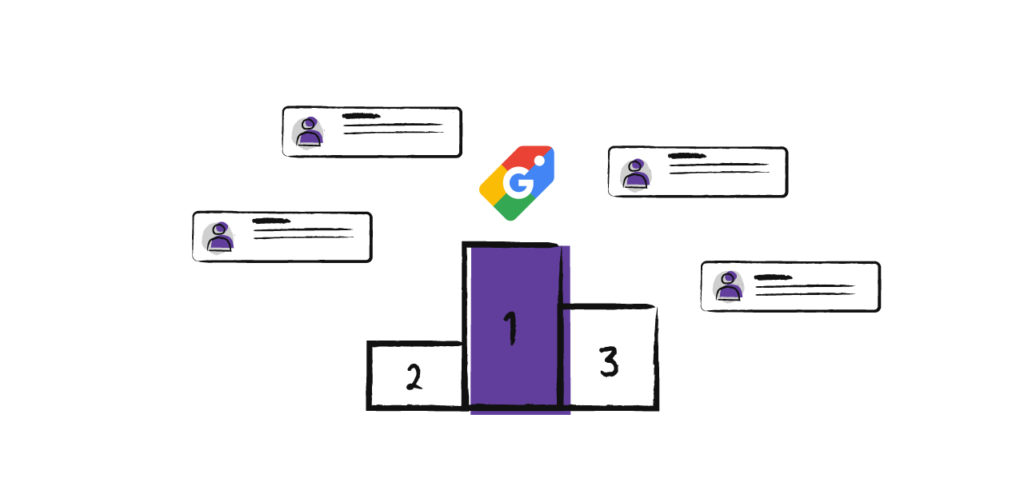We’ve always known product reviews are important for building customers’ trust, but research shows they’re now more important than ever. 81% of consumers say a company’s trustworthiness matters more in 2020 than it did in 2019.
To build shoppers’ trust, they need to be able to findall those great product reviews you have lurking on your store. You need to put those reviews front and center—and Google is the place to do it.
Google is the number two destination for product searches (after Amazon) and offers free tools to make sure shoppers can see just how satisfied your customers are, right off the bat.
It’s easy to get started with Google Shopping reviews, but a surprising number of businesses still don’t use them. Seize this competitive advantage, and learn how you can leverage reviews to increase traffic on your ads and boost sales.
What are Google Shopping reviews?
Google Shopping reviews are broken into two categories: product ratings and seller ratings. Both programs aggregate customer feedback and give you a star rating (out of five total stars). This star rating is displayed on your Google Shopping listings and ads (for product ratings) and Google text ads (for seller ratings).
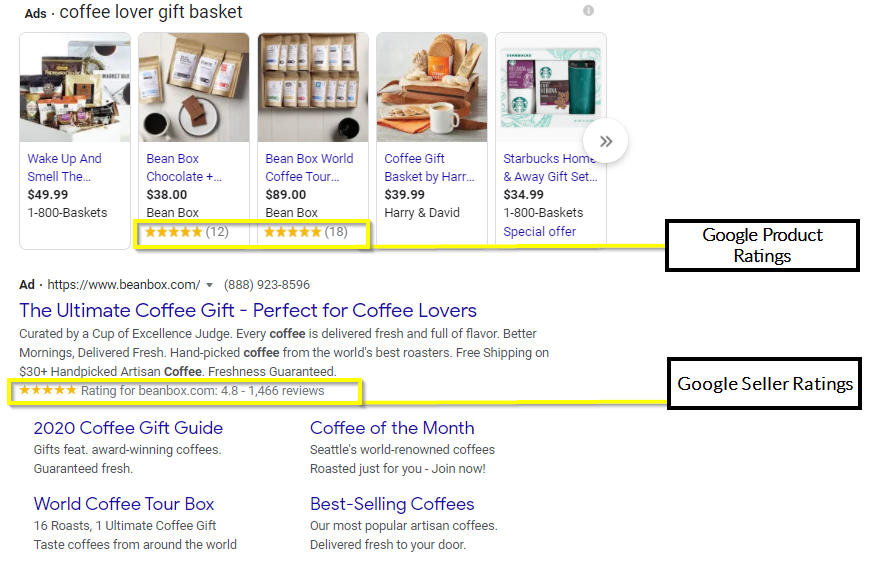
The benefits of Google Shopping reviews for your business
Time and time again, the data shows a strong relationship between positive reviews and sales. In fact, 94% of online purchases are products with an average rating of four or five stars.
The two factors that seem to matter most to shoppers are the quality and volume of reviews. Everyone likes to see four- and five-star ratings (although shoppers seem to give more trust to products with just under five stars).
However, Womply Research found that businesses with 82+ reviews bring in 54% more yearly revenue—and revenue nearly doubles when a business has 200+ reviews.
Since Google Shopping shows multiple products from different sellers, reviews make even more of an impact. Positive product ratings make both your listings and product ads stand out from competitors.
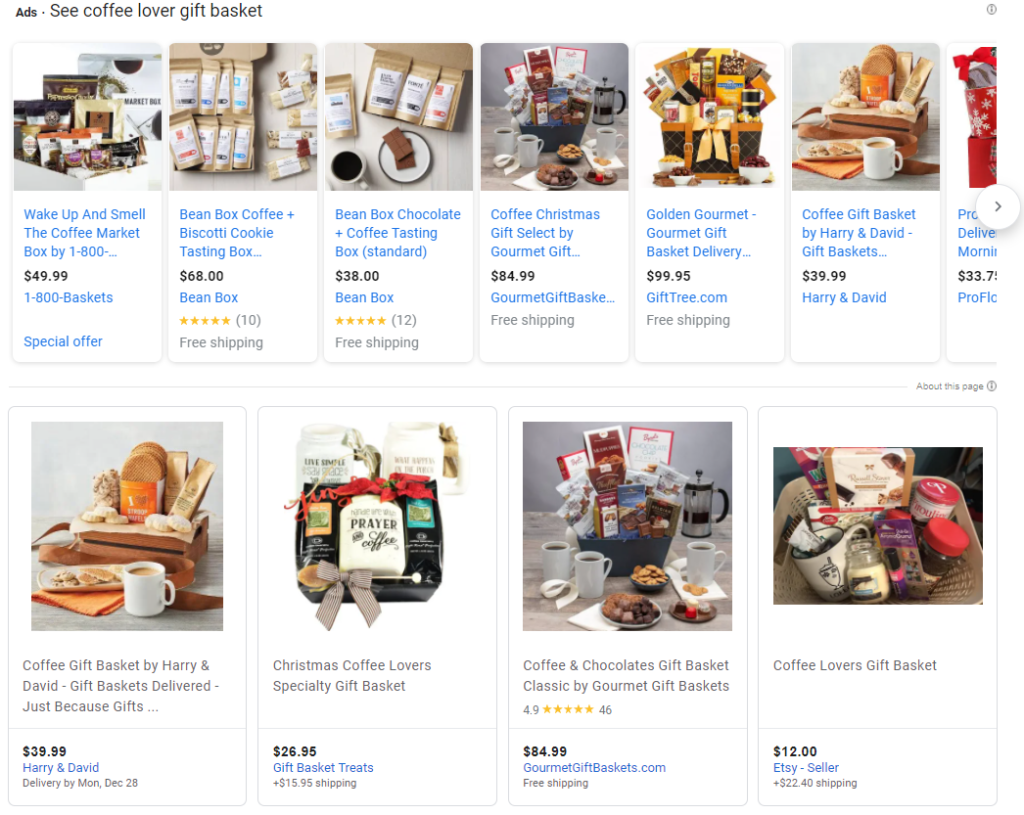
The impact of this attention is particularly important for advertising with Google Shopping.
How customer reviews improve shopping ad performance
When you advertise on Google, the goal is simple: Drive as many conversions as you can for the lowest cost-per-click (CPC) possible. (If you’re unfamiliar with how Google advertising works, check out our guide to using Google Ads for ecommerce.)
To achieve this objective, you need to win the bid auction, where Google determines which ads will show on relevant searches. The size of your bid is the main factor in winning the auction—and the top ad placements—but it’s not the only factor.
The other major part of the equation is your Ad Rank. Google grants higher Ad Rank to the sellers who please the shoppers who click on their ads. High Ad Rank gets you access to better ad positions and lower CPC, which improves the overall profitability and sustainability of advertising on Google.
To net this coveted Ad Rank, you need to demonstrate a history of high click-through rates (CTRs) and conversion rates. In Google’s eyes, a high CTR means your ads are relevant to the shopper. High conversion rates show that your ad ultimately satisfied the shopper’s needs.
Now we get to the importance of product and seller ratings. Research by Yotpo, a major ecommerce review platform, finds an average lift of 24% in CTR for Google Shopping ads that include product ratings and a 17% increase in CTR for text ads with seller ratings.
When you include seller and product ratings in your Google Ad arsenal, you essentially create a positive feedback loop for your entire advertising initiative:
- Social proof from Google Shopping reviews likely creates a higher CTR and increased conversions.
- Increased CTR and conversions raise your Ad Rank.
- High Ad Rank leads to better ad positions on Google for a lower CPC.
- Your ads see a better return on investment as a result. You can pour that revenue into improving your products and customer service—which leads to more positive Google Shopping reviews.
These benefits don’t require any additional steps on your part, either. Once you set up your review feeds for product ratings and seller ratings, Google will automatically show reviews in your ads. (Note that the seller ratings ad extension will only function if you have the requisite number of reviews and if your average rating is 3.5 stars or higher.)
If you’re not already syncing your product reviews with Google, you’re now officially out of excuses. The long-term benefits (and potential ad spend savings) are just too good to ignore—especially considering the small time investment required to reap them.
The 3 Google Shopping review programs you need to start using
Reviews for your Google Shopping listings and ads come in two formats: product ratings and seller ratings. Both work with Google Customer Reviews to add even more value to your business. Here’s how these programs work and how you can get started.
Google product ratings
Product ratings display starred reviews for products on both Google Shopping’s comparison shopping engine and Google Shopping ads. In both cases, Google shows the number and average star rating for the product. These ratings are pulled from three main sources: your website, third-party review aggregators like Trustpilot, and Google Customer Reviews (more on that program in a bit).
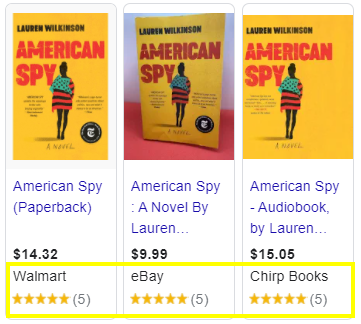
Add reviews from your website to your Google Shopping product feed to display product ratings. All you need to do is create a review feed within Google Merchant Center.
You can set up this feed in one of two ways. The manual upload method requires you to submit a new review feed whenever you want to update the data. To remain eligible for the product ratings program, you’ll need to do this at least once a month.
Alternatively, you can use a scheduled fetch. With this method, Google periodically checks the appropriate files on your website and updates product ratings automatically. While fetching involves a little more upfront work, it’s well worth the effort to keep your product ratings as fresh and accurate as possible.
Learn more about uploading your product feed data to Google.
Third-party aggregators—services like Baazarvoice, Trustpilot, and Yotpo—manage and display product reviews on your website. Google syncs with over a dozen popular review aggregators, making it far easier to automatically update your product ratings on Google Shopping.
Currently, Google product ratings support the following list of review aggregators:
- Annex Cloud
- Avis Verifies
- Bazaarvoice
- Echte Bewertungen
- eKomi
- Feedaty (Zoorate)
- Feefo
- Opinioes Verificadas (for merchants in Brazil, Portugal, Colombia, and Spain)
One important thing to bear in mind with product ratings: If you sell a product that’s also sold by other merchants, your product ratings will appear alongside those merchants (as in the example below). Google populates reviews based on the globally unique product identifiers found in your product feed, such as an ISBN for a book. Any other seller using product ratings will have their reviews included in the melting pot.
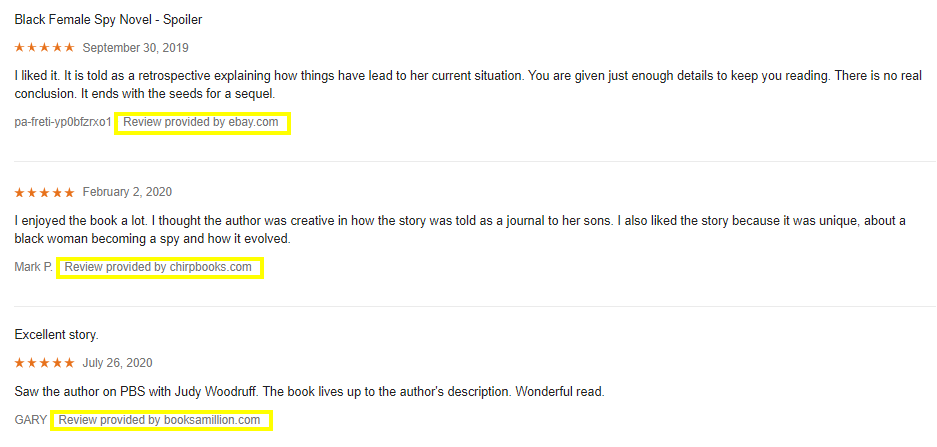
While good product ratings draw attention and help establish trust with buyers, they also don’t necessarily tell your shoppers why they should buy from you. For that, you need seller ratings.
Google seller ratings
Whereas product ratings focus on the quality of an item, seller ratings refer to the customer’s overall experience with your business. The buying process, speed of shipment/delivery, quality of products, and responsiveness of customer support all play into this star rating.
Seller ratings don’t appear in product ads, but they do appear in two other key placements: text ads and Google Shopping seller comparisons.
Google text ads have a seller ratings ad extension that you can easily enable with a couple of clicks. Shoppers will see a star rating for your business on these ads, as well as the number of reviews and on-time delivery details.
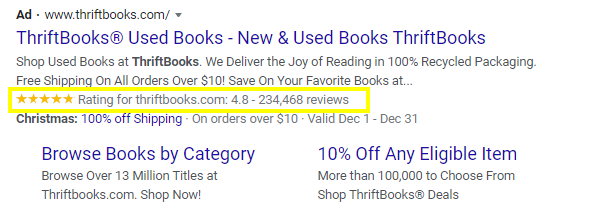
Google Shopping product listings include seller ratings in their “compare prices from # stores” section. If you can’t offer the lowest price on a product, positive seller feedback provides a much-needed competitive advantage.

To be eligible to display these ratings, you’ll need at least 100 seller reviews from the past 12 months. This requirement ensures that the reviews give an accurate picture of the seller.
To check if you already have a seller rating, you can use the following URL—just make sure you substitute your site address for “example.com.”
https://www.google.com/shopping/ratings/account/lookup?q=www.example.comSeller ratings are pulled from a couple of different sources, including consumer research from Google (although that program usually only affects larger retailers). Ratings can also be sourced directly from certain independent review sites. Most stores will want to enroll in Google Customer Reviews in order to gain the volume of seller ratings needed.
Google Customer Reviews
Google Customer Reviews is a free review service that automatically prompts customers to review their experience with you once a product is delivered. When your website is configured with the program, customers will be prompted at checkout to opt in to a post-purchase Google survey.
Once delivery is confirmed, Google will email the customer and ask them to rate their experience with your business. Customers who click on this email can choose to only give a star rating or add commentary on their experience with your business. You can also customize this review request to solicit product-specific feedback.
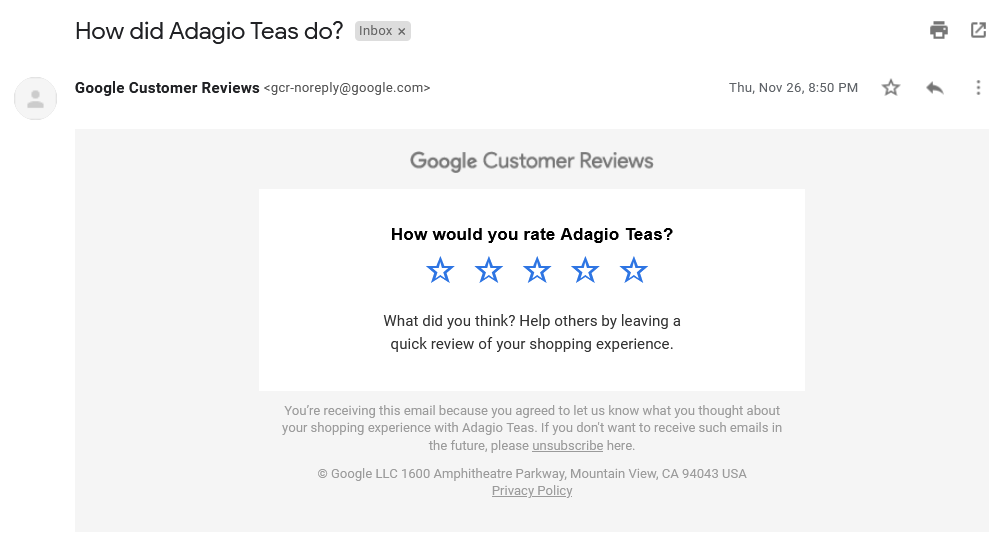
Google then takes this review and automatically adds the feedback to your seller rating and/or product rating.
The trust and name recognition of Google adds weight to the review request, and the simplicity of the feedback process is hard to beat, even compared to top review aggregators. Google Customer Reviews is a free and easy way to create more value for your business.
To get started, opt in to the Customer Reviews program inside your Merchant Center account, under the Growth tab. From here, you’ll walk through the process of customizing your feedback survey and integrating the survey into your website’s code.
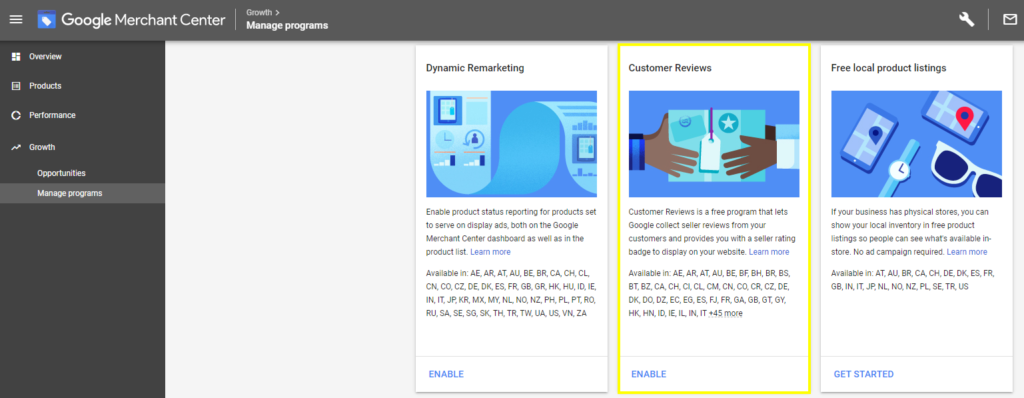
Google has a step-by-step guide for setting up Customer Reviews on your website. Some popular ecommerce platforms also have features that make this even easier.
- Set up Google Customer Reviews with Shopify
- Set up Google Customer Reviews with BigCommerce
- Set up Google Customer Reviews with WooCommerce
Don’t let the technical side of this intimidate you. Once you have everything set up, the program runs more or less autonomously. From there, Google Customer Reviews will help you raise the visibility and trustworthiness of your business profile.
3 ways to cultivate better Google Shopping reviews
So you set up your account with Google Shopping reviews—now what? While Google makes it easy to leverage customer feedback, their tools mean nothing if you’re not getting positive reviews. These four tactics, along with a good dose of patience, will go a long way toward improving your ratings on Google over time.
1. Ask customers for reviews
Customers who’ve had a bad experience with your company are more likely to leave a review than those with good experiences. Happy customers tend to just move on with their lives.
To avoid an unfair ratio of negative to positive reviews, you need to actively seek feedback (good and bad) from all your customers. The best way to do this is with post-purchase emails.
Before we go on, it’s important to note that, according to Google’s policy for seller ratings: “Merchants are not allowed to offer their customers financial incentives to write reviews of any kind. This includes but is not limited to free samples, gift cards, discounts on future purchases, or anything of monetary value.”
This policy certainly makes the job of getting reviews more challenging, but not impossible. The trick, as with marketing emails, is to make the ask in the right way, at the right time.
- Use messaging that is personal, conversational, and on-brand. Reviews.io has some great templates and examples to get you started.
- Send your review requests at the right time. First, of course, you want to be sure the customer has actually received their product—otherwise, things could get awkward. But there are also certain times of day when people are more likely to leave reviews. Check out Reputation’s research on how to time your request emails.
- Subject lines can make or break someone’s decision to open your email. Make sure you A/B test your subject lines to see which ones drive opens. (Yotpo has some good advice on conducting this subject line testing.)
Experiment and apply what you learn. Keep track of the response your request emails get and look for the trends that lead to more reviews.
2. Respond to all your product reviews—both the good and bad
We’ve probably all seen business replies on Yelp that make us cringe—defensive responses that don’t acknowledge the customer’s frustrations. But far from being a business faux pas, replying to customer reviews is crucial to growing your business. According to Womply Research, businesses that reply to at least 25% of their reviews see 35% more revenue on average. Even businesses who only replied to a single customer review still saw an average revenue increase of 4% compared to those who didn’t reply at all.
The reason for this is fairly simple. When you respond to a review, you show both customers and shoppers that you care about their experience.
A fast, thoughtful response to negative feedback gives you a chance to make things right for the customer in question as well as showing future customers that you are committed to quality service. In some cases, customers will also change their review after receiving a reply from the seller.
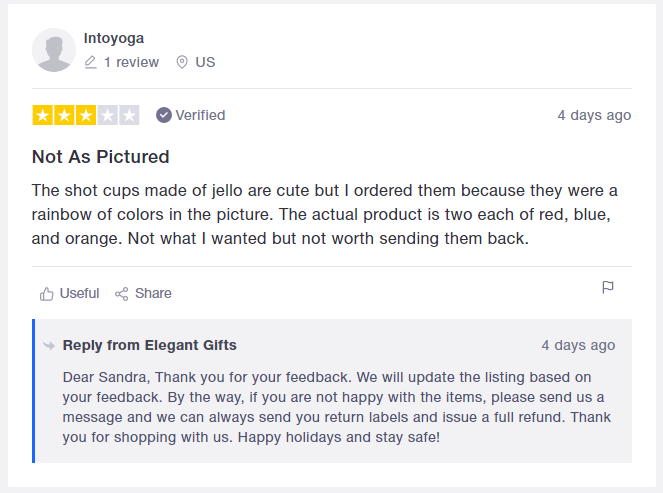
Don’t just respond to the people with problems, though. Shoppers like to see a company that’s engaged with its customers. Personal replies to positive reviews show shoppers the human side of your business and help establish confidence in you as a seller.
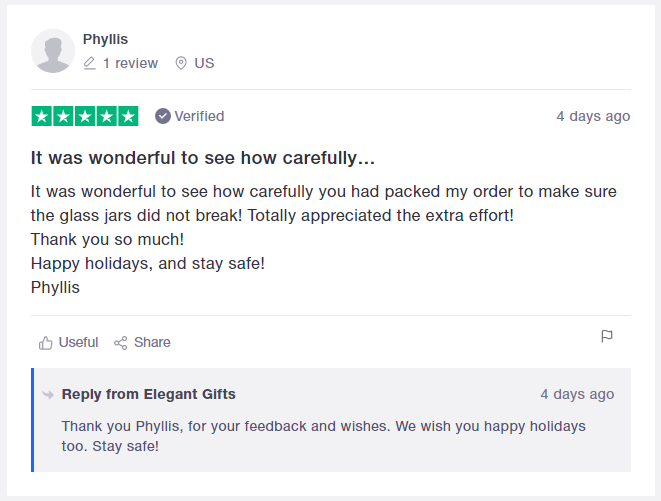
Not sure how to write a review reply? HubSpot has a great free collection of review response templates to help you get started.
3. Focus on providing excellent customer service
Ultimately, the quality of your Google Shopping reviews comes down to the quality of your products and service. That’s obvious, but it’s worth reiterating. There’s no way to game the system—if your product and customer service aren’t up to par, you won’t get good reviews. So, as you work on bulking up your presence in seller ratings and product ratings, don’t forget what’s most important.
Meet customer expectations for fast delivery service. Amazon has raised everyone’s demands when it comes to shipping. And while you may not be able to match free two-day shipping, it’s important to remember what you’re up against. Be transparent with customers about fulfillment and shipping times, offer the fastest feasible delivery timeframe, and make sure you can live up to what you promise.
Develop a strong customer experience strategy. Smooth common friction points for online shoppers by providing a mobile-friendly website and fast checkout process. Personalizing the shopping experience also goes a long way toward garnering favor with customers.
Small ecommerce businesses won’t have the dedicated customer service centers of larger stores, but that’s no excuse for poor customer service. Make sure you have a plan for supporting your customers, no matter how small your operation. The speed and professionalism with which you handle customer issues will impact your seller ratings more than just about anything.
To learn more, check out our guide to customer service for ecommerce. This resource covers how to deliver winning service on every channel.
It takes time to grow a strong review program—so get started!
It takes time to build a high volume of positive reviews, but this effort has long-term dividends for your business. So if you’re just getting started and don’t yet have enough reviews to make a splash on Google Shopping, don’t sweat it. Focus on what you can do today—building a sustainable program for cultivating reviews.
Experiment with ways to encourage reviews (within Google’s guidelines). Interact with customer feedback. And most importantly, learn from your buyers’ input. If you take their feedback to heart, you’ll find plenty of ways to improve your product and encourage even more positive reviews.
